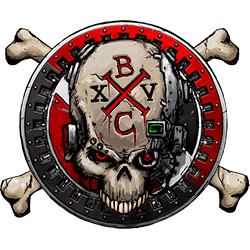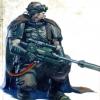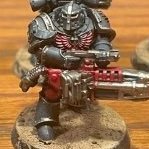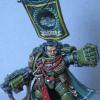-
Posts
4743 -
Joined
-
Last visited
GreyCrow's Achievements
-
 bloodhound23 reacted to a post in a topic:
New to 30k - What Books do I need?
bloodhound23 reacted to a post in a topic:
New to 30k - What Books do I need?
-
 Helias_Tancred reacted to a post in a topic:
Company structure guidance for a Raven Guard Beginner
Helias_Tancred reacted to a post in a topic:
Company structure guidance for a Raven Guard Beginner
-
 Helias_Tancred reacted to a post in a topic:
Company structure guidance for a Raven Guard Beginner
Helias_Tancred reacted to a post in a topic:
Company structure guidance for a Raven Guard Beginner
-
 tychobi reacted to a post in a topic:
Company structure guidance for a Raven Guard Beginner
tychobi reacted to a post in a topic:
Company structure guidance for a Raven Guard Beginner
-

Company structure guidance for a Raven Guard Beginner
GreyCrow replied to Rusted Boltgun's topic in + RAVEN GUARD +
No worries Rusted! Ultimately, take my perspective as a basis for reflexion. I don't pretend to be the be all end all of tactics. There's no set blueprint from GW about 'This is how to design and manage your Space Marine army', I don't think even they thought about it this way either. Rather, I'm pretty sure they design cool units/models that are then priced in points and cash to maximize revenue :D The biggest issue we face is the deployment standard operating practices for Chapters. Is a company a self sufficient unit ? Is it part of a larger Chapter tactical logistics ? How do Marines actually fight ? I don't think this has ever been explicitely mentionned. Perhaps in some Forgeworld books like Badab (would need to check). Rule system wise, it seems that the tactical philosophy of 40k is very inspired by World War 1 tactics from the game rules, but with some modern unit designs. World War 1 showed a lot of line tactics, fire superiority through long range fire, and bayonet charges for decisive action. CQC in WW1 was very viable due to the trenches and the low rate of fire of man portable weapons at the time : When you are in a trench, you can freely stab other people as you are in cover from most other directions. You can see this in all the main arts, where it's 2 glorious lines stretching for miles, fighting against each other. __ Another issue comes : Battle scale. There is such a thing as fire density. A stealthy tactic will work better avoiding large concentration of enemy force and will not engage the combat until they find a sufficiently weak point to punch through, then fade away. At Raven Guard levels, that would mean that the Raven Guard would mostly fight 500 points games, with highly mobile units. On a 4x6'' board, 500 points favour highly mobile units rather than pure firepower, because the fire support elements can cover much less arcs of fire and there are more terrain pieces than units. A force with 1 Squad of Intercessors, an HQ and 3 Plasma Inceptors will have a massive advantage on a 4x6'' at 500 points. Same board at 2,000 points, since you can't avoid the firepower so much, you need the ability to place effective shots down range + tank the incoming fire. At 2k games, you have to think down the opposition before going in with mobile forces. So effective long range fire support is absolutely critical. __ The lists I mentionned above were mostly to illustrate the fire and maneuver concept, mostly against infantry lists. A more standard list would be the following : Primaris Captain Primaris Lieutenant 30 Intercessors (Power Fist on the Sergeant) 1 Plasma Redemptor 20 Heavy Hellblasters 6 Plasma Inceptors 1 Plasma/Gatling Redemptor All of this coming at just 1995 points. This is what I usually play with Ultramarines Chapter Tactics, for example. Since Ultramarines have smaller deployment options than Raven Guard, you gotta build in fire superiority very early on, but their Chapter Tactics allow for better mid game mobility. The typical UM strategy is tank turn 1, while concentrating fire in one area of the map (gotta punch through the enemy system), then move to take advantage of what you created. 20 Heavy Hellblasters are nasty good at doing that. Without Seal of Oath (reroll all to hit and to wound against 1 enemy unit), just using the Captain and Lieutenant rerolls, they throw about 18 wounds on a 4++ Imperial Knight Turn 1, which is quickly dispatched by the Bolt Rifle shots from the Intercessors and the Dreadnought firepower. As either them or the Dread usually takes fire priority, the Inceptors drop in with to reinforce lost Plasma guns, and open different fields of fire to go hunt units that are hiding behind Line of Sight. __ As much fun as watching Marines punch people to Oblivion, you have to win the fire superiority in 40k. It's important to isolate enemy fire, punish them from being out of line of sight, so you can maneuver closer range elements more effectively later on. T'au are usually perceived as OP because of the fact that their fluff pushes the players to secure fire superiority, due to their very effective ranged gameplay. Old Aeldari battle focus allowed them to have very good fire superiority : Dark Reapers moving out of cover, shooting heavy weapons and full BS, then going back into cover. Besides pure actual registered damaged, you need to punish the enemy from fighting in its preferred fighting situation, do deny his advantage while building yours. __ 1000 points is where I believe there are more room for personal creativity of builds : The density of units on the board and cover is such that there doesn't seem to be a type of units that is significantly more effective. Shooting still has a slight advantage, but 9th LOS rules and recommended terrain density allow for different army styles to play. For me, 1000 points seem to be the sweet spot that favours a decent chunk of Troops and very flavourful support units, without becoming completely gamey. __ To close the discussion : Keep in mind that Games Workshop is first and foremost a models company before being a games company. Their DNA is in the hobby, and the game is mostly made to provide a good casual time for people to watch their dudes fight each other. (Heavy reliance on RNG in gaming indicates a more casual nature for game types. Family board games are purposefully designed to rely on dice to avoid powergaming in families). -
 duz_ reacted to a post in a topic:
Company structure guidance for a Raven Guard Beginner
duz_ reacted to a post in a topic:
Company structure guidance for a Raven Guard Beginner
-
 Warhead01 reacted to a post in a topic:
On Assault Marines and Reivers
Warhead01 reacted to a post in a topic:
On Assault Marines and Reivers
-
Yep, exactly ! Focusing on the kill is the folly of Chaos, we Astartes are tacticians first and foremost ! Joke aside, the difference between them and Bladeguard is you can keep your CPs for something else. I’d rather have the Bladeguard kill stuff in mêlée rather than be a bullet magnet, if I bring them. They’ll get much more mileage for that purpose. Agreed that they get more mileage in other Chapters due to the additional deployment options here. Despite how they are presented in the fluff, Assault Marines and Reivers are not mêlée damage units. — On the matter of CP usage for Reivers for instance : The Raven’s blade : - on 2 6 men Bladeguard units : 2 CP for SFTS, 1 CP for Raven’s blade. 3 CP total. - on 2 10 men Reivers : 1 CP due to built in Deep Strike Attack volume potential is higher as well with 81 attacks on the charge for models with combat blade versus 50 for the Bladeguard. Works good for chaff and will work better against armies with tons of weak infantry while Bladeguard will work better against elite armies. There is also that strat that denies Obsec and can mess with actions. Once again, not arguing that they are the best at everything because they aren’t. En masse though they are not a useless tool. — The Marine meta right now seems more about smaller more elite armies. Bringing 20 Reivers on top of a lot of Intercessors is something opponents are not well equipped to deal with. Would be thinking of a list along these lines for instance (using my very dogmatic army construction build) Primaris Captain Primaris Lieutenant 30 Stalker Intercessors 20 Autobolt Intercessors 2 Plasma / Gatling Redemptors 20 CQC Reivers with chutes — Deploy the 30 long range Intercessors in the middle of the board with the 2 Dreadnoughts and the HQs. Deploy 1 squad of 10 Autobolt on each side, with the Reivers in reserve. Strike from the Shadows or See but remain unseen the 2 Autobolt squads as far as sensible in a way to force the enemy to concentrate force on one. Opponent is likely to focus the main firepower on the Dreads. Turn 2 drop the 20 Reivers in support of the less damaged one and Raven’s Blade a target. — I’m biased with Troops these days because I spent most of the last year playing with the Ultramarines doctrine and using lots of infantry. There is beauty in volume of chaff and some surprises in terms of effectiveness. It’s not fitting everyone’s fantasy of how marines should run though.
-

Tau Hammerheads Main Gun vs Repulsor Exeuctioner Main Gun
GreyCrow replied to Lord Blackwood's topic in + ADEPTUS ASTARTES +
That's a pretty beasty gun for sure ! Gotta change the strategy vs T'au and bring in some decent fire support. Can't rely on just crawilng up the board hoping to tank it. 2 Hellblaster squads will be standard for me when facing T'au. -
 Warhead01 reacted to a post in a topic:
On Assault Marines and Reivers
Warhead01 reacted to a post in a topic:
On Assault Marines and Reivers
-

Company structure guidance for a Raven Guard Beginner
GreyCrow replied to Rusted Boltgun's topic in + RAVEN GUARD +
Just wanted to add that everything written above is purely speculative and should be in no circumstances taken as a 'standard operating procedure' for companies! -
Warhead, from what you write, I understand you equip them with the carbines, correct? And totally in line with your point about forcing people to dedicate obsec units to get the point back. When you drop 20 Reivers, either the guy is forced to bring back 20 or more non Obsec models, either the guy is forced to divert Obsec units back.
-
 GreyCrow reacted to a post in a topic:
On Assault Marines and Reivers
GreyCrow reacted to a post in a topic:
On Assault Marines and Reivers
-

Company structure guidance for a Raven Guard Beginner
GreyCrow replied to Rusted Boltgun's topic in + RAVEN GUARD +
Hey Rusted ! Welcome to the Ravenspire ! First of all, keep in mind that the lore hasn’t been designed to give a be all end all functioning structure to the Codex Chapters. There is a lot of rule of cool and room for head cannon. First of all, the level at which the Astartes fight is a bit muddy and seems very dependent on the different chapters and authors. Tabletop wise, if you want an “authentic” company, you will limit your play style quite a lot. That doesn’t mean you can’t be effective, but playing the army will be less about creating a working system, but executing an existing system as best as you can. — How “might” a Primaris company work in 40k ? Keep in mind I’m not a military expert, all these are hypotheses ! According to the Codex, Guilliman made sure that Codex compliant Chapters were able to fight in all manners of warfare. That means that each Chapter must be able (aka has the means) to deploy all needed assets to conduct the war comfortably. In the Codex, Companies 2 to 5 are Battle companies while 6-9 are Reserve companies. 1 are veterans, 10 are Scout forces. In the lore, it is often mentioned that while conducting a campaign, elements from Reserve companies bolster the battle companies. Based on this, I expect the battle companies to not be lone fighting forces and rely a lot more on Chapter Assets and cross company resources than one thought. I’m sure there are some 40k Forgeworld books that would support that too. — Keep in mind that in warfare, unit levels are not only a coherent measurement of fighting force but also a coherent logistical unity. Not everybody fight at once, logistics (being able to bring the right tool for the right job at the right time) would indicate that units that are less immediately useful do not participate in the fight, but remain withdrawn able to be called on when needed. — If we assume that a company operates independently without support of the Chapter (so relies exclusively on the 6 battle line squads, 2 close support, 2 fire support squads and 2 Dreadnoughts), then the standard operating procedure could be as follows : - Unlikely to deploy all at once ! Why would you need Close Support when Fire Support is preffered ? - Likely to deploy as a “Fire and Maneuver” standard tactic : a static force providing fire support/a mobile force moving for flanking positions and assault under cover of the fire teams. Fire and Maneuver is further evidenced by Bolter discipline doubling the shots at full range for stationary Marines. - Likely to operate standardly with 3 Battle Line Squads + 1-2 Dreadnoughts as the core of any engagement. Why Dreadnoughts as core ? Combined Arms seems to be the name of the game in 40k, an infantry only force seems to be without tactical responses when faced with exclusively anti infantry guns. - Likely to dedicate this 3+2 configuration in either Fire or Maneuver (including the Dreadnoughts). - Likely to use any available supporting element to fill the other role, and bring a sizable contingent to fill that role. Example : Intercessors with Stalker Bolt Rifles in a “fire role” Would likely bring 2 full Inceptors Squad as a maneuver role. - Likely to bring a minor contingent of the other type of support units to supplement the main line. That squad would provide a small “in between” role to bridge the fire and maneuver roles. Example, at 1985 points : Primaris Captain Primaris Lieutenant 30 Stalker Intercessors 2 Plasma Redemptors 12 Plasma Inceptors 3 Bolter Aggressors — This is by no means a 100% winning list and CERTAINLY don’t use it as a template to build your company. This is a bit of an extreme example where you have a very static gunline with good damage projection at range, at the expense of board control early game. The goal with that army is to castle up early on and bait the opponent to spread his forces to use his mobility advantage on capturing objectives/doing secondaries. Once he feels confident, then dropping the 12 Inceptors on one side of the board in Turn 2-3 and then slowly bringing them forward. In the case of an aggressive army, deploying the Inceptors on the backfield and letting the enemy come will make the pounce easier. -
All good points here ! @Sanguinary : Sorry for the tongue in cheek reply brother ! I have seen too many hobbyists limit themselves and not enjoy the battles because they felt forced to follow the d’la our of the month GT list. Nevermore! I want to free my brothers! You had to in 7th because of how unbalanced the game was, but I feel 9th gives a lot more opportunities to explore new builds. You are 100% correct than on the paper they don’t look appealing at all. I do believe that it’s because they need more bodies on the table to start being effective, and that’s not really reflected in the unit stats. @Warhead : Tell me how it goes brother with 20 ! I wanted to try to field 30 but it felt a bit too much investment (both pts and cash) It seems you got the idea on what we can do with them! ;) @Ikka : You are very right in the sense that there are different options I’ve had quite good luck with Ultramarines, running 20 autobolt Intercessors suicide rush the board shooting all around to cause a distraction (on top of a core Troops of 30 Rifle Intercessors) Raven Guard can afford to be more aggresssive with a similar build thanks to the infiltrate and deep strike strats for sure. It’s definitely not a head on mêlée killer, for sure. Better options on the board. I do like to gamble on the adversary taking the bait of an easy kill. Who doesn’t like to wipe models off the board ?:D @Wrath : I totally get what you mean, this is exactly how I see them being used. Either as a rush suicide force, either as a deep strike distraction ahead of a tac squad. In any case, always up to do some TTS practice with y’all, for the Ravenspire !
-
 GreyCrow reacted to a post in a topic:
On Assault Marines and Reivers
GreyCrow reacted to a post in a topic:
On Assault Marines and Reivers
-
 GreyCrow reacted to a post in a topic:
On Assault Marines and Reivers
GreyCrow reacted to a post in a topic:
On Assault Marines and Reivers
-
 GreyCrow reacted to a post in a topic:
On Assault Marines and Reivers
GreyCrow reacted to a post in a topic:
On Assault Marines and Reivers
-
 GreyCrow reacted to a post in a topic:
On Assault Marines and Reivers
GreyCrow reacted to a post in a topic:
On Assault Marines and Reivers
-
 Warhead01 reacted to a post in a topic:
On Assault Marines and Reivers
Warhead01 reacted to a post in a topic:
On Assault Marines and Reivers
-
Happy new year Brother ! I’m sure your tactical work doesn’t limit itself to just copying what other people do at events :D Happy to go on a tabletop simulator game to experiment !
-
Don’t think units, think points. Let’s put it this way : would you rather lose 400 points of blade guard or 400 points of Intercessors or 400 points of Reivers ? I know for me that would be the Reivers. You can use them as a throwaway unit to tie the big guns up, especially in scenarios where you can’t really protect everybody. That also gives you some very mobile units with mass of bodies to get objectives, to force the enemy to dedicate Troops to them. They are basically a volumetric annoyance. —- Looking at Reivers : - I see them as competing role with Aggressors and Redemptors where they will be a bullet magnet with a potential threat if not dealt with - In case where the enemy is bringing many gun of high quality, the deep strike makes them a bit more resilient than Aggressors - Against large anti tank firepower, they are more resilient than Redemptors - They bring their points back by taking fire away from the other units, with low risk of loss, since their damage contribution will be lower
-
 Noserenda reacted to a post in a topic:
Idiot question : Principia Bellicosa Support Squads
Noserenda reacted to a post in a topic:
Idiot question : Principia Bellicosa Support Squads
-

Idiot question : Principia Bellicosa Support Squads
GreyCrow replied to GreyCrow's topic in + WARHAMMER: THE HORUS HERESY +
Haha word! I guess I'm not the only logistics nerd around :D -

Idiot question : Principia Bellicosa Support Squads
GreyCrow replied to GreyCrow's topic in + WARHAMMER: THE HORUS HERESY +
Yes, they are. Heavy Support Squads at a company level asset, so there must be a company of them to be split in support of different companies like you said. That also would imply that the Bataillon/Chapter level is the standard unit for self sufficient warfare in the Heresy. It's probably written somewhere but I must have skipped it. That would mean that most operations are planned at the Chapter level. I'd imagine it'd be safe to assume that most Chapters would be working in a combined arms force quite as a standard operating philosophy rather than be purely an infantry force. -
 duz_ reacted to a post in a topic:
Dracos' 9th Ed tactica ... more salty musings ;)
duz_ reacted to a post in a topic:
Dracos' 9th Ed tactica ... more salty musings ;)
-

Idiot question : Principia Bellicosa Support Squads
GreyCrow replied to GreyCrow's topic in + WARHAMMER: THE HORUS HERESY +
Thank you all ! It's interesting to see the different takes on the topic ! Spontaneously, I would assume that this is a Tactical Support Squad, but I'm wondering whether or not FW let it open for other types of squads to consider. In a 'typical' 40k board, the HSS would seem like a more natural support squad loadout, while the TSS would feel more suited to ZM games due to the lower range of their weapons. -
This is a big opportunity for Raven Guard players, since they are not necessarily played in the meta and can surprise more than one unattentive opponent. Do they suck? Absolutely! But they have a secret very few know and understand. People usually compare them at a squad by squad level, and yes, they are unremarkable. The secret ? Take 2 big squads and have them play together. In the lists I build these days, I usually take 350-400 points in a support 'group' for a full squad of Troops. 20 Reivers dropping in support of 1 Intercessor squad is a major nuisance that the enemy does have to deal with. They can clog guns, bully smaller Troops. Most players tend to evaluate the effectiveness of a unit by what it can kill. In that dept. Reivers and Assault Marines are lagging behind. Think of it in terms of how much volume of fire they take away from the rest of the force. In tactical doctrine, it takes 180 shots to deal with 40 MEQ wounds. It has the added benefit of also not inspiring much threat, is often overlooked or not prioritized, and is a very effective build. Try it one day and let me know how it works for you! :D
-

Dracos' 9th Ed tactica ... more salty musings ;)
GreyCrow replied to Dracos's topic in + RAVEN GUARD +
Troops are fantastic in 9th edition honestly. I've played more with an Ultramarines successor force in 9th than Raven Guard just out of nerdism for Roman lines which I find absolutely cool and Ultramarines do reward lots of Troops very much with special relics like Seal of Oath. Troops have a secret benefit that most post don't see! They don't do much damage at first glance, but it does add up over time. 30 Intercessors in Rapid Fire or Bolter Discipline range, with a Captain + Lieutenant rerolls : 13.61 MEQ wounds out of Tactical Doctrine, 18.14 MEQ wounds in Tactical doctrine. 6 Gravis Wounds, so 2 dead Gravis, and that includes the Stratagem that improves the save versus D1 weapons. 9 Gravis Wounds, so 3 dead Gravis, with the same conditions as above. Now points wise, that doesn't seem great, but 3 Gravis versus 9 Intercessors is a big loss. That might not seem fantastical and it is not. Per turn. But do that for 3-4 turns and the casualties are starting to pile up. Unchecked for 4 turns and assuming 2 Turns of Tactical doctrine, Intercessors can deal 63 MEQ wounds. And that is just shooting, not counting any damage from Assault which is sure to occur. __ Specifically to Raven Guard, the deployment options are phenomenal. Raven Guard are masters of dodging damage and controlling the engagement parameters. Strike from the Shadows strat on 30 Intercessors is very, very violent until Tactical Doctrine. They will take 0 damage and emerge out of nowhere concentrating force on a single target. In the meantime, you can use dodging tactics and defense stratagems on the rest of your supporting elements, plus the brilliant CT to severely mitigate damage. Choosing when and where you fight is critical. Imagine you have 30 Intercessors in Strike from the Shadows, and the enemy has a relatively spread out line. You can concentrate 30 Intercessors on 10 in a flank in Tactical doctrine with the Deep Strike capability and delete a squad. Now that gives the advantage, assuming the enemy had 30 Troops originally, now you are winning the attrition with a 3:2 ratio on the board. That may not seem much, but that means the enemy can't delete 1 squad of your Troops in 1 turn with his Troops only. This forces him to commit other forces to the battle to beat your line Troops. Which now makes his behavior predictible. __ I could go on and on about Troops for hours so I'll stop there. They are very under rated in the meta because they have nothing ostensibly fancy about them. Which is a big part of their strength since nobody expects them to do anything! There are 3 basic principles in Tactics that Troops really help with : 1) Bringing the right tool to deal with the right target : By forcing the enemy to fire on Troops, it's easier to move about and deliver support units where they matter the most. 2) Superior local concentration of force : In 40k, the 2 armies are roughly equal, so to win a game one has to bring more local force in 1 part of the map, in sequence. In that scenario, Troops are not weak. Especially resilient Troops like Marines can force the enemy to dedicate large volumes of fire into 1 area to deal with 10 basic dudes, if you decide to split your forces. If it takes 400 - 600 points of the enemy force to reliably wipe out 1 Intercessor/Tactical Squad, it's 400-600 points that are not used elsewhere! Therefore, you bring 1800 points versus 1400-1600 which is already a 15% to 20% advantage. Even better if you can concentrate more force locally. 3) Attacking the enemy from multiple angles : Not speaking of geometrical angles here. If you bring 6 Inceptors and 10 Intercessors to the same engagement, the opponent will have 2 deploy 2 different strategies to deal with them effectively. You need high D weapons to screw the Inceptors, and you need a decent volume of fire to deal with the Intercessors. It's 2 different answers that need to be brought, which takes up more resources. We love thinking of glorious triumph in 1 on 1 combat as part of the western trope of knights and honour. Honour is PR. Gentlemanly duels were usually taken when one knew something that the other didn't. Gentlemanly is winning with an unfair advantage that the opponent cannot see, so it seems fair but isn't. -
 GreyCrow reacted to a post in a topic:
Dracos' 9th Ed tactica ... more salty musings ;)
GreyCrow reacted to a post in a topic:
Dracos' 9th Ed tactica ... more salty musings ;)
-
A friend of mine shared the preview of the new Hammerhead Railgun. The Fire Warriors for the Tau are merely a speedbump but they'll be seen more and more to screen the bigger lines. I am not a fan of the 'Shoot the choppy ones', 'Chop the shooty ones!' doctrine. Let's punish the enemy for using their strengths. Tau like to shoot and stand back, so let's bring a long range heavy support unit in the form of Hellblasters (Pure Primaris) to still put shots in their preferred range. I don't believe in exclusively rushing to assault in a gunline. Long range support in the form of tanks or heavy weapons squads will draw their fire in better priority, which is expected, and that should buy more time to press on with the line troops. Even with a fast moving Raven Guard, it's still better to ensure the fire is drawn away from the rest of the force.

















